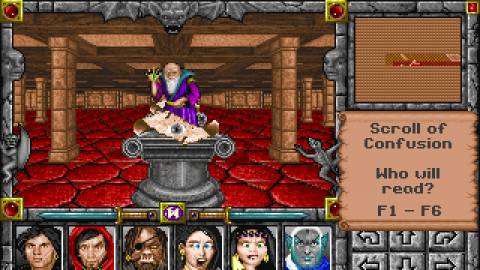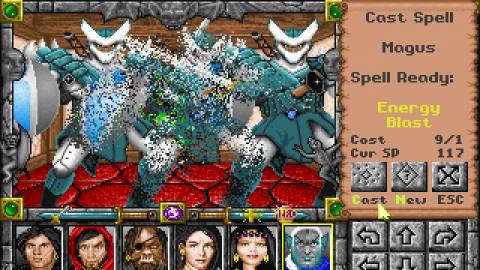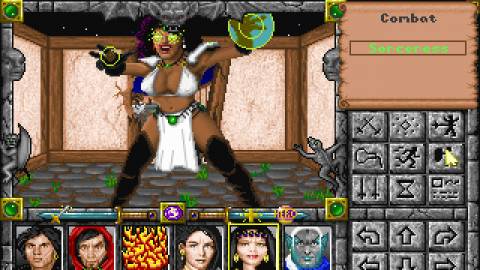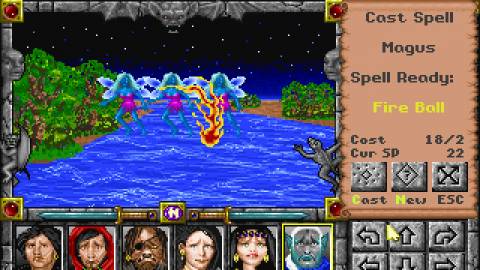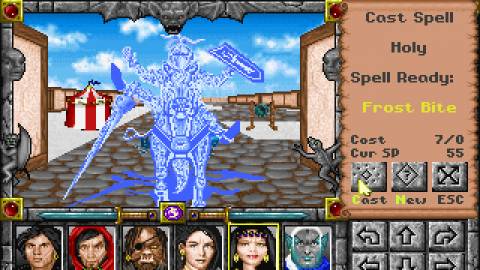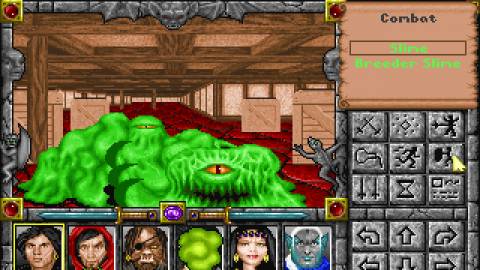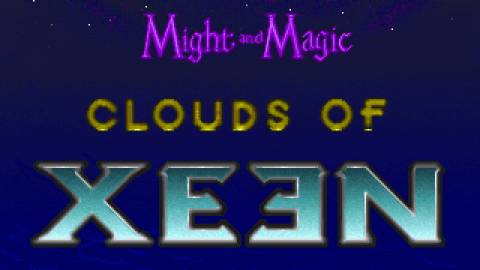Overview
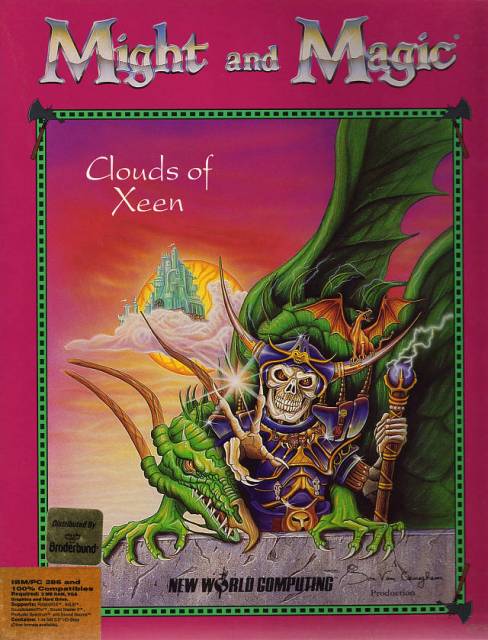
In this game, the players are set against the nefarious Lord Xeen who has apparently taken control of the land from King Burlock and his advisor. The players are tasked to stop him, but are free to explore the open world an approach the quest at any time they choose.
An "escape" option was also made available within the game called "Mr. Wizard", introduced in Isles of Terra. If the player found themselves lost, they could call upon his services and be teleported to their hometown. The cost, however, would be in valuable gems.
The combat heavy nature of the series would continue with this entry although there were many puzzles and secrets to be discovered within the game. Possibly due to the heavy modifications made to the engine from Might and Magic III (such as with skills and the inclusion of two new classes), it did not offer an option to import characters from its predecessor. Players had to start with either an all-new party or the pre-built one provided.
Special sub-quests for character classes were also included in the game to enhance their abilities.
As was often the case at this time with the PC related releases of the title (such as on MS-DOS or the Amiga), a number of items were included with the game to enhance its immersion:
- The manual for the game with a detailed introductory story describing the events leading up to when the players are brought into the game
- A Quick Reference card that described the basic controls, interface, and listed spells
- An illustrated map of the world
At the end of the game, the player's score was also tallied and a mail-in address provided for the player to mail it to the Ancients at New World Computing in order to be added to the Hall of Legends.
World of Xeen
Both the Clouds of Xeen and Darkside of Xeen, in addition to offering lengthy quests and a large, open world to explore, also introduced a revolutionary new concept that combined both worlds into one. If the player had both Clouds and Darkside loaded on their PC, they could create the World of Xeen and fulfill the Ancients' plans. This is where the sci-fi aspect of the series comes into play once again through an elaborate ending that fulfills the ultimate destiny of both halves of Xeen.When the World of Xeen is created, the player can embark on a third quest and travel between both halves of Xeen through the pyramids that had been locked until now. Quests will take them to both sides of the world and once completed, will unify both the land and their people in one world.
Story
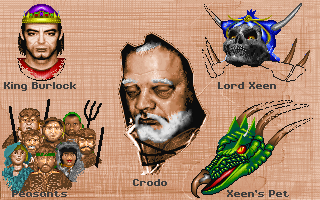
In Clouds of Xeen, the story provided by the manual indicated that your party had been experiencing a recurring dream in which King Burlock's advisor, Crodo, has been speaking to you. In it, he relates the backstory for the quest that they must undertake to save the land.
He tells the party that a man claiming to be Roland, King Burlock's long lost brother, had returned. Roland had left on a mission that would take him deep into Mount Firestone in a search for the "Land below the Land" and after many years, was presumed to have failed. But with his return, everyone had many questions as well as shared in the excitement of his possible success.
Crodo was suspicious, however. He watched as Roland related tales of mysterious treasures and great power. Roland spoke mostly about a relic called the "Sixth Mirror" and was the only magic mirror that was portable considering its size. With it, the user could step through it just like the other five of its kind, but the Sixth Mirror could easily be carried.
King Burlock, convinced by his brother's words, financed expeditions to find the Sixth Mirror. No one succeeded, but Roland continued to push for his brother to fund further expeditions. The search grew more feverish with every report of failure and the King began to ignore the land. His health began to falter, servants quickly forgot their duties, and the treasury continued to bleed gold. Crosdo resolved to speak to the King before it was too late.
That night, he awoke to the sensation of dark magicks being worked from somewhere within the castle. He walked into the hallway and could hear sounds coming from Roland's room. He peeked through the keyhole and to his horror, saw Roland sitting cross legged with a black tome in one hand. From the charcoal diagram on the floor, the image of a knight with horns upon his helm had emerged to which he spoke.
Crodo goes on to say that he must have made some kind of noise for at that moment, Roland turned and stared at the door. Crodo fled just as the door exploded from its frame. He ran deeper into the castle but was cornered by Roland who raised his hands as if to cast a spell of his own as Crodo wove defenses around himself in the same way.
Roland mocked Crodo then and the advisor feigned defeat. Just as Roland grew complacent, Crodo hurled the spell that he had been saving at him. Dancing blades sped through the air and exploded against Roland's flesh, tearing it apart and revealing a grinning skull beneath his ravaged face. But he still stood as an undead thing that faced him.
Crodo asked who he was, and the mockery of Roland replied that he was Lord Xeen who would soon become master of the world. With a gesture, Crodo fell unconscious and soon awoke in a room that suffocated his magic allowing him only to send these dreams as his only means of escape. Looking through the window of his cell, he could see the castle and discerned that he was in Baron Darzog's Tower.
With that, the party had gathered together even as the dreams had ended and through many adventures, eventually faced the nefarious Lord Xeen, rescuing Crodo and convincing King Burlock of the truth of his brother, Roland. They would also recover the Scepter of Xeen, although the power behind it would remain asleep for now. But upon Xeen's defeat as his castle was ripped into the sky, another face appeared.
It was the helmeted knight that Crodo had seen in the vision within Roland's room, and it laughed at the characters. It told them that they may have defeated his general, Lord Xeen, but that the Darkside of Xeen would remain his.
The Legend of the Unification
Pertinent to the World of Xeen is a legend that ultimately reveals the Ancients' plans for Xeen and its like.Centuries ago, the Ancients created Xeen and a thousand worlds like it, scattering them like seeds throughout the stars along with their people. Although the cultures on each world were as diverse as the people themselves, each seed had only one goal: to reach its chosen star and then achieve its destiny through a process known only as Unification.
Each world had its own Guardian to watch over it and ensure that its destiny could be fulfilled, guiding their assigned world through its journey through the stars. When the time was right and the moons aligned, the Guardian of Xeen would send messengers to both Lands to announce the Unification. The Guardian would open the pyramids allowing people to travel in between both halves of Xeen.
Long separated, the people of Xeen would greet each other like long lost family and begin trading stories, goods, and perhaps even find new homes on the other side of the world. They would also make themselves ready for the coming Unification and the Guardian would then select special champions to go forth and awaken the Four Slumbering Servants of Air, Fire, Water, and Earth.
The rulers of both sides of Xeen would then send ambassadors to each others' courts. The Darkstone Tower would open and the seal to its Cloud would also swing wide. There, in a ceremony within the observatory, the rulers will lay the Scepter and the Cube upon the Altar of Joining. Great magic will take hold of these Lands and join them together as one, united world.
Gameplay
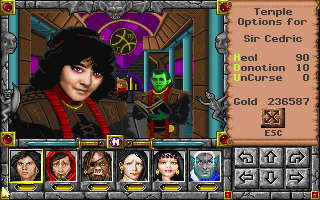
The game was also considered quite detailed as well as difficult. Players were required to maintain a stock of food in order to be able to rest outside of an in to regain hit and spell points. Bashing open locked doors would often set off traps if they were not disarmed. Leveling was not automatic.
Once a character had earned the requisite experience, it must be spent at a training ground in order to improve their statistics and abilities. Gems were often required to cast higher level spells and characters could also die from old age (natural or not), although the proper spells could alleviate its effects. New spells would have to be learned at a Guild and did not automatically appear in their spellbooks as in other RPGs (most notably, many JRPGs).
Characters could also be afflicted with a number of debilitating conditions which often proved incredibly fatal to starting parties. Sex and alignment would also restrict certain characters from entering specific areas or in equipping certain items.
Players were also able to save anywhere they wished as long as the area they were in did not have any restrictions on doing so.
Towns and dungeons were much more elborate although the series continued to use a grid-based movement system with 90 degree turns. Automapping was also available along with automatic loot recovery and the use of visible encounters allowing for pre-emptive ranged attacks.
Races
The game allows the player to select among five different races in building their characters. As with most other RPGs, certain races have slightly better statistics in certain areas than others.The five races are:
- Human - Strong resistance to fear and some resistance to sleep spells. Average statistics make this race a good choice without any glaring weaknesses.
- Elf - They have a strong resistance to fear and are generally excellent at spellcasting
- Dwarf - Some resistance to poison, stronger and hardier than the other races. They make excellent fighters but poor spellcasters.
- Gnome - Nimble and quick, they can make great paladins and decent spellcasters.
- Half-Orc - They have a moderate resistance to sleep spells, are decently strong, and can make great fighters.
Statistics

The basic statistics used in the game seem derived from the Dungeons and Dragons model of statistics, although carry different names so as to differentiate themselves. They are:
The basic statistics used in the game seem derived from the Dungeons and Dragons model of statistics, although carry different names so as to differentiate themselves. They are:
- Intellect - General knowledge. Important to sorcerers as it can affect spell points. Important to archers later on at higher levels as they begin learning sorcerer spells.
- Might - Raw strength. Important to any fighting class such as Knights and Paladins. Affects the damage a character can inflict in melee combat.
- Personality - A character's general degree of appeal to others. Particularly important to clerics as it affects their pool of spell points. Important to paladins when, at higher levels, they begin learning cleric spells.
- Endurance - Stamina. Affects how many hit points a character initially has to start with and will gain every time they level. Particularly important to fighters.
- Speed - Agility and general quickness affecting initiative. A faster character improves (increases) their Armor Class rating making them harder to hit.
- Accuracy - A character's ability to land hits during combat. This is particularly important to archers.
- Luck - Measures the general chances of a character succeeding when all else seems to have failed. Random and unpredictable.
Skills
Player characters could learn as many of these as they could find in the game and they could enable the party to solve various puzzles or get to hard-to-reach places with ease. Many classes would start out with one and one or two were class restricted.- Pathfinder - Dense forests will no longer inhibit a party with at least two characters versed in this skill.
- Swimmer - Every character must learn this skill in order to be able to swim through water as long as it was close to shore. Swimming too far out was not recommended.
- Thievery - A vital skill for Robbers and Ninjas. The higher the skill has been trained, the better the odds are in getting through that lock.
- Cartographer - Only one needs to know this skill, but it activates the automapping. Important in being able to save what graph paper you might have.
- Direction Sense - Enables the gem in your interface to display which way you are facing and also puts an arrow on your automap to show that information as well.
- Spot Secret Doors - The gargoyle on the interface will start waving its claw when a thin wall is detected nearby.
- Arms Master - This increases your chance of hitting in combat and is related to the character's level.
- Danger Sense - The bat at the top of the interface will start moving if a monster can see you.
- Crusader - All party members wishing to enter certain restricted areas within the game must have this skill. Otherwise, it offers nothing else.
Classes
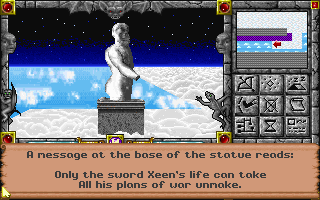
- Knight - These are considered the warriors of the game in being able to use any item or armor aside from those exclusively designed for another class or have an opposite alignment. They are able to attack more than once every round at higher levels. Starts with the Arms Master secondary skill.
- Paladin - While not quite as good as a Knight in combat, they are able to wield and equip as many items as they can with the same restrictions. At higher levels, they are also able to cast Clerical spells. Starts with the Crusader secondary skill.
- Archer - These are the missile experts of the party and are able to use any weapon. Unlike the Paladin, they are also able to use missile weapons even in hand-to-hand combat. At higher levels, they are also able to cast Sorceror spells. They are restricted in the kind of armor that they can wear, however, such as chain mail or any lighter armor being the only types available for them and they cannot use a shield. Has no secondary skill.
- Cleric - The traditional healer class, they can only wear light armor but they can also carry a shield. Weapons are restricted to a club, mace, flail, a staff, or a hammer. They cannot use ranged weapons such as bows. At higher levels, their healing abilities come in extremely valuable much further into the game. They are also the travel experts with spells that can teleport a party out from a dungeon, to a town for a quick rest, or enable them to walk on water to reach special areas. Has no secondary skill.
- Sorceror - They can only wear padded armor and their choice of weapons are extremely limited and it almost goes without saying that they can't carry a shield. However, their spells more than make up this lack of physical protection and offensive ability with some of the most devastating attacks in the game. Starts with Cartography as their secondary skill.
- Barbarian - This character can use most weapons and starts with the greatest number of hit points out of any other class. A true tank character. Starts with no secondary skill.
- Robber - The traditional thief of the game, what they lack in offensive and defensive ability are made up with their talent for disarming traps and locks. They can fight as well as a cleric, but are far better at keeping the party safe from poison gas or fireballs erupting from chests. Starts with Thievery as a secondary skill.
- Ninja - This character acts much like a fighting Robber, but they cannot carry a shield. They can use most one handed weapons but only swords specific to their class. Two handed weapons are limited to staves and the naginata. However, they do have the "assassinate" ability which is automatically attempted with their first attack. If successful, additional damage will result. Starts with Thievery as a secondary skill.
- Ranger - Can use most weapons and armor along with being able to cast clerical or sorcerous spells to a certain extent. Starts with Pathfinding as a secondary skill.
- Druid - As with the Sorceror, they are poor fighters. They can only use light armor and weapons but are able to cast Sorceror and Cleric spells, although not to the same extent as those dedicated to such disciplines. They also start with twice as many spell points as Rangers do. Starts with Direction Sense as a secondary skill.
Character Status
In addition to their class and race, characters have a number of other statistics that players will need to keep track of during the game.- Level - This is a measure of how experienced a character is. Characters start out at level 1 and can only gain levels once enough experience is earned and the necessary training is purchased.
- Spell Points - A measure of how many points are available to any one character for use with spells. Certain spells have higher point requirements than others.
- Hit Points - The number of hit points a character has remaining. At zero hit points, a character does not necessarily die. Instead, they fall unconscious. However, if they suffer anymore damage after reaching zero, death is the only result.
- Armor Class - The higher this number, the more resistant a character is to damage. Armor, spells, shields, and speed are among the factors that can help determine it.
- Age - Characters start at 18 years of age and grow older as the game continues on. As they become older, their skills begin to deteriorate and vital statistics will begin to drop. After around an age of 80, the character can actually die from resting overnight. Age can be delayed or reversed using spells or in discovering special locations.
- Experience Points - These are earned from defeating monsters and quests. These determine whether a character is ready to advance to the next level through training. The point requirements for reaching the next level usually double.
- Gems - This measures the number of gems that a character is carrying. Gems are valuable as they are consumed in order to cast many higher level spells.
- Gold - The coin of the realm earned in a variety of ways whether it is from monsters or in discovering long lost treasures.
- Food - Characters start with ten food units (up to a maximum of 40). One food unit represents a day's rations and is consumed when camping to replenish hit points and spell points during rest.
- Condition - A character's current status, whether they are asleep, poisoned, dead, etc..
Each character also has their own backpack which can carry a maximum of six items.
Alignment
There are no absolutes in Might & Magic nor does this affect the story progression of the game. Instead, it largely determines certain restrictions such as whether a piece of equipment can be used or whether a particular character can enter specific areas.Locations
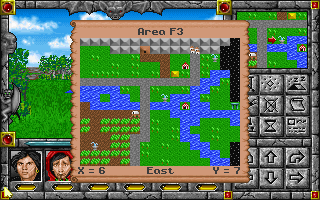
Towns share many of the same services.
- Shops - Where supplies, such as new armor and food, can be purchased.
- Temples - Where sick or injured characters can be healed.
- Training Grounds - Important for advancing character levels once enough experience has been earned.
- Taverns - Buy food, hear tips, create characters, and manage parties here
- Blacksmith - Buy and sell weapons and other items, identify the unidentifiable, and fix what is broken because weapons and armor can break.
- Guild - Where new spells can be learned once one is at a sufficiently high enough level
Combat
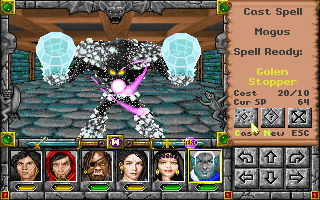
By running from combat, the party would then end up somewhere on the map near to where they had fled. By using hotkeys or the mouse, the player can easily manage the flow of combat with their favored peripheral.

 PC
PC


